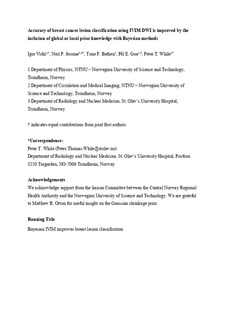Accuracy of breast cancer lesion classification using intravoxel incoherent motion diffusion-weighted imaging is improved by the inclusion of global or local prior knowledge with bayesian methods
Journal article, Peer reviewed
Accepted version

Åpne
Permanent lenke
http://hdl.handle.net/11250/2622000Utgivelsesdato
2019Metadata
Vis full innførselSamlinger
Originalversjon
10.1002/jmri.26772Sammendrag
Background
Diffusion‐weighted MRI (DWI) has potential to noninvasively characterize breast cancer lesions; models such as intravoxel incoherent motion (IVIM) provide pseudodiffusion parameters that reflect tissue perfusion, but are dependent on the details of acquisition and analysis strategy.
Purpose
To examine the effect of fitting algorithms, including conventional least‐squares (LSQ) and segmented (SEG) methods as well as Bayesian methods with global shrinkage (BSP) and local spatial (FBM) priors, on the power of IVIM parameters to differentiate benign and malignant breast lesions.
Study Type
Prospective patient study.
Subjects
61 patients with confirmed breast lesions.
Field Strength/Sequence
DWI (bipolar SE‐EPI, 13 b values) was included in a clinical MR protocol including T2‐weighted and dynamic contrast‐enhanced MRI on a 3T scanner.
Assessment
The IVIM model was fitted voxelwise in lesion regions of interest (ROIs), and derived parameters were compared across methods within benign and malignant subgroups (correlation, coefficients of variation). Area under receiver operator characteristic curves (ROC AUCs) were calculated to determine discriminatory power of parameter combinations from all fitting methods.
Statistical Tests
Kruskal–Wallis, Mann–Whitney, Pearson correlation.
Results
All methods provided useful IVIM parameters; D was well‐correlated across all methods (r> 0.8), with a wider range for f and D* (0.3–0.7). Fitting methods gave detectable differences in parameters, but all showed increased f and decreased D in malign lesions. D was the most discriminatory single parameter, with LSQ performing least well (AUC 0.83). In general, ROC AUCs were maximized by the inclusion of pseudodiffusion parameters, and by the use of Bayesian methods incorporating prior information (maximum AUC of 0.92 for BSP).
Data Conclusion
DWI performs well at classifying breast lesions, but careful consideration of analysis procedure can improve performance. D is the most discriminatory single parameter, but including pseudodiffusion parameters (f and D*) increases ROC AUC. Bayesian methods outperformed conventional least‐squares and segmented fitting methods for breast lesion classification.
Level of Evidence: 3
Technical Efficacy: Stage 2
J. Magn. Reson. Imaging 2019.